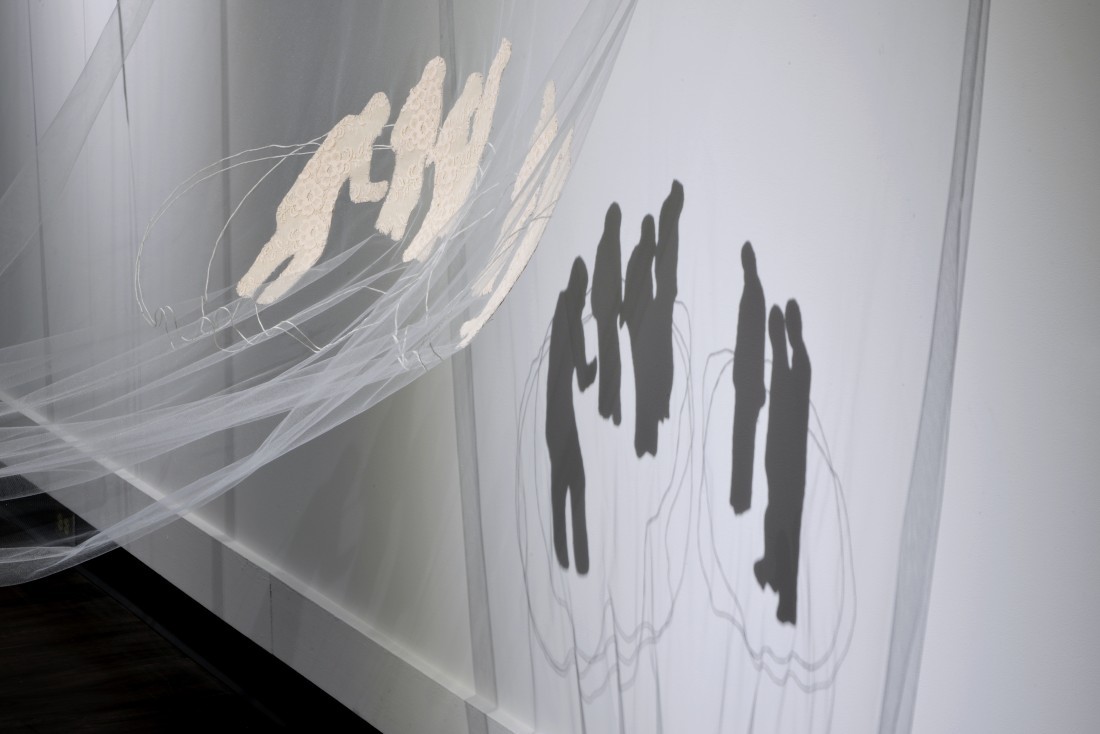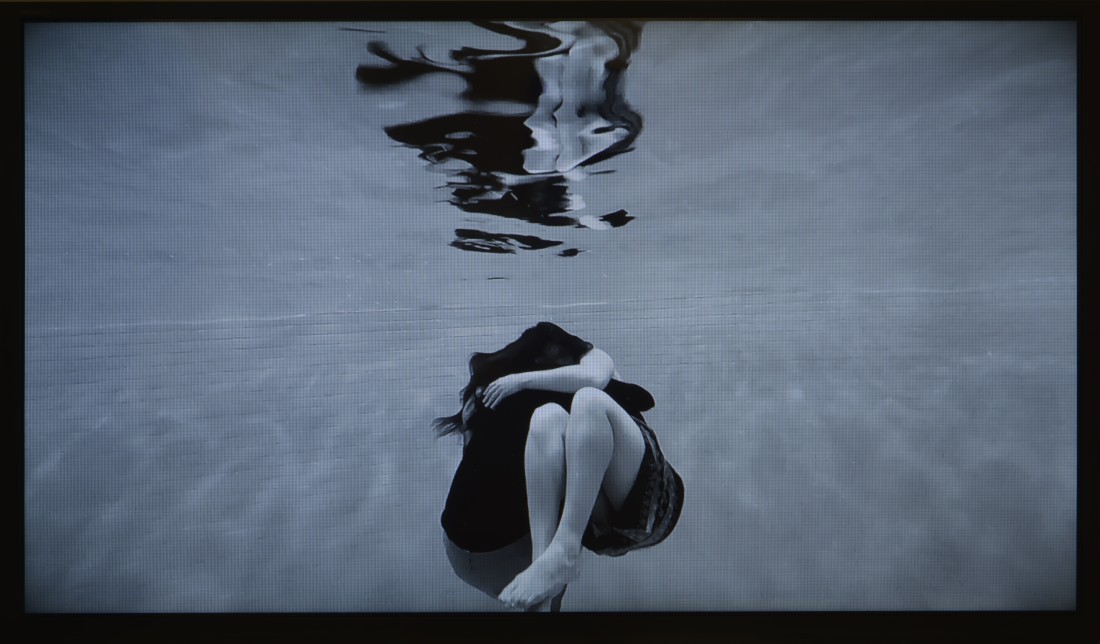Becky Thera
In “Embrace,” Becky Thera proposes certain continuities and transgressions between two sites of gendered isolation. Throughout the exhibition, she looks at photographs and written records of the Shackleton Expedition and her experience of artistic swimming (formally known as synchronized swimming). The two hemispheres are united by the context of lockdown isolation, where the intimate mingling of bodies became a far-off memory for many people. In these tangled, tangential spaces, Thera traverses questions of gender, individuality, extremity and collectivity.
Entering the gallery, I was met with the sound of dripping water. It is a slow drip; the kind I associate with melting ice or the rhythmic, incessant metronome of a leaky tap. It has layers of reverberation and echo. One layer is audible in the recording itself and the other is provided by the expanses of the Art Gallery of Regina’s high ceilings. The room is dim, but bright spotlights carve out alcoves for large, sheer textile works that float off the wall as if they have frozen in place while trailing behind a phantom. They cast sharp silhouettes of chunky figures onto the gallery wall. Some of these figures are individuated and others are clustered, merging into an abstract mass of bumps and protrusions.

Becky Thera, Patience Camp, 2021, tulle, fabric, embroidery thread, 91.44 × 137.16 × 243.84 centimetres. Installation view at the Art Gallery of Regina. Photo: Don Hall.
In the far corner, there is a series of videos of swimmers huddled together and floating in a swimming pool. In some images they are curled up and buoyant, twinned by their reflection on the surface of the water. These videos are slow and hypnotic—a far cry from the acts of Olympic ferocity typifying the videos of artistic swimming with which I am familiar. I am transfixed by the hypnotic suspension of these videos and the camaraderie of the performers. I am also interested in the way the structural homosociality of artistic swimming mirrored that of the crew of the Endurance, the ship carrying the Shackleton expedition. It is worth noting that shortly after the opening of “Embrace” it was announced that, for the first time, the Olympics will allow men to compete in artistic swimming. Whether they will compete in the same arena as women on gender-neutral teams is another question entirely, along with the consideration of trans and non-binary swimmers.
Many of the works in the exhibition are connected by an oblique and idiosyncratic logic. Some of the didactic material for the exhibition helped to give context to Thera’s gestures but is sometimes overly optimistic in its claims. It stressed the sustained touch that is inherent to hand stitching and embroidery. This tactile intimacy recalls an excerpt highlighted by Thera from Shackleton’s published account of the treacherous expedition he undertook. He recalled, “When we were not on watch we lay in each other’s arms for warmth. Our frozen suits thawed where our bodies met, and as the slightest movement exposed these comparatively warm spots to the biting air, we clung motionless, whispering each to his companion our hopes and thoughts.”
While Thera read this quotation as a space where the men of the Endurance act in ways that are “not traditionally masculine,” I think it is worth noting that at this time, intimacy between men was less likely to be marked by the anxiety we know today. That now-familiar anxiety, in some ways, is a reaction to gay liberation. At the time of their voyage, homosexual acts between men were illegal and would continue to be in England and Canada until 1967. I would characterize this comfort as a reaction to extreme social repression rather than a utopian space of “non-judgemental, non-gendered tenderness,” as Thera describes it. It is sometimes the ineffability of extreme queer phobia that makes space for these kinds of historical situations possible. For me, it is possible to read this intimacy as a condition of patriarchal homophobia rather than a crack in its surface.

Becky Thera, Never Alone, 2020, video, 40 seconds. Installation view at the Art Gallery of Regina. Photo: Don Hall.
In a similar way, the treatment of gendered materials like lace, floral motifs, embroidery and needlework, which, according to the curatorial text, “seek to tear apart binary gender division,” might do more to enforce that binary than question it. The figures and composition of the large textile pieces were drawn from the photographs of Frank Hurley, the photographer of the Endurance. They are rendered here with lace and tulle, two textile products that are almost completely associated with femininity while what they portray are artifacts of the kinds of “heroics” I associate with the nearly suicidal extremes of masculinity. There is a bluntness to this juxtaposition, which is tempered somewhat by the shadows they cast. These silhouettes lead to an ambiguity not only of gender but of individuals and body parts. As I look without specific recollection to the images being referenced, I wonder which bumps are legs and which ones are heads. It’s even more confusing to wonder which bumps belong to whom and what they might do with them in the dark and freezing depths of the night.
Sometimes, in an attempt to make a meaning that is legible, “Embrace” runs the risk of reinforcing the binaries it looks to question. In her artist statement Thera says she seeks to “embrace feminine power, while refusing boundaries.” As I walk through the exhibition, I am reminded of the way that questions of gender are both elusive and sticky. How can something be so hard to address and impossible to ignore? How do you use gendered signifiers to deconstruct their own reading? Is there a feminine power that is accessible without the definitional boundaries created by Western gender binaries? How do you know when something is too big to be encompassed by a single embrace? How do you embrace without holding on too tightly? How do you know when it is time to let go? ❚
“Becky Thera: Embrace” was exhibited at the Art Gallery of Regina, from June 16, 2023, to August 10, 2023.
Nic Wilson (he/they) is an artist and a writer based on Treaty 4 land where they graduated from the MFA program at the University of Regina.

